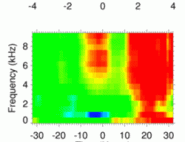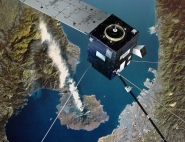Inner radiation belt particle acceleration and energy structuring by drift resonance with ULF waves during geomagnetic storms
An international team, of which Scientists from IRAP and LPP, has just demonstrated the very frequent presence of coherent acceleration, in a few dozen minutes, of the electrons and protons of the Earth's radiation belt by Ultra Low Frequency waves. These ULF waves are associated to the sudden compression of the Earth magnetic field during a magnetic storm in the Earth Orbit. Thanks to the French mission Demeter and to the on board particle detector, which has an excellent energy resolution, complex energy structures could thus be brought out and explained for the first time. This work was published in the Journal of Geophysical Research.
"Inner radiation belt particle acceleration and energy structuring by drift resonance with ULF waves during geomagnetic storms", J.-A. Sauvaud, M. Walt, D. Delcourt, C. Benoist, E. Penou, Y. Chen, C. T. Russell, Journal of Geophysical Research, 2013, doi:10.1002/jgra.50125.
Geographical distribution of the 200 keV electrons flux at 650 km altitude (in color), with in red the South Atlantic Magnetic Anomaly. Here the low geomagnetic field causes the decrease of the particles mirror point down to DEMETER satellite altitude. The regions (black) located at the North and the South of the anomaly present the energy bands characteristic of the resonant acceleration of the particles with ULF waves. It is the asymmetry of the geomagnetic field which allows their detection at low altitude. At higher altitudes these zones encircle the Earth. |
It is the resonance between the particle drift movement around the Earth and the ULF waves electric field that creates these structures. These waves could be detected directly from the ground and characterized by comparing the simultaneous data from magnetometers in the United States and in Europe, particularly at the magnetic Observatory in Chambon-la-Forêt. These are quasi-monochromatic pulses of large wavelength that travel around the Earth with speeds depending on their azimuth wavelength. Each mode resonates with particles of which drift speed around the Earth is equal to their phase speed. It is a coherent phenomenon that transports particles toward the Earth and accelerates them efficiently. This phenomenon is observed in inner belt, at distance from 1 to 1.7 Earth radius, where the waves have a period of about 20 minutes, and at larger distance (2.5 - 3.5 Earth radius), where the waves have a characteristic period of about 1 minute. These accelerations, seen on Earth close to the South Atlantic Magnetic Anomaly, are frequent processes that go with the magnetic storms, even with low amplitude.
![]() This resonance had not been demonstrated previously because the usual particle detectors were designed to study the flax variations measured in large energy windows or bands where the structures were buried. From Demeter observations, digital simulations were done coupling the high energy particles movements with an analytical wave model taking into account their main characteristics. These simulations reproduce very well the observations.
This resonance had not been demonstrated previously because the usual particle detectors were designed to study the flax variations measured in large energy windows or bands where the structures were buried. From Demeter observations, digital simulations were done coupling the high energy particles movements with an analytical wave model taking into account their main characteristics. These simulations reproduce very well the observations.
![]() Nowadays, after the launch in August 2012 of the two American RBSP satellites dedicated to the study of the Earth's radiation belt, the international community possesses adequate tools to determine how the waves are produced, either by direct coupling between the solar wind and the Earth's magnetosphere, or by internal instability and how they affect the global dynamics of the Earth's radiation belt. Similar processes are expected in the magnetosphere of the gas giant planets Jupiter and Saturn.
Nowadays, after the launch in August 2012 of the two American RBSP satellites dedicated to the study of the Earth's radiation belt, the international community possesses adequate tools to determine how the waves are produced, either by direct coupling between the solar wind and the Earth's magnetosphere, or by internal instability and how they affect the global dynamics of the Earth's radiation belt. Similar processes are expected in the magnetosphere of the gas giant planets Jupiter and Saturn.

